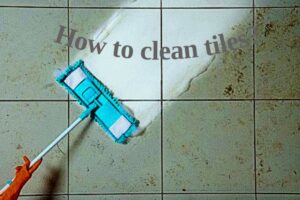 Tiles are a great flooring or wall material. However, they can collect a lot of bacteria, dirt, dust and grease. In order to prevent those, bathroom and kitchen tiles must be regularly cleaned. Not only will you ensure that they are clean and disinfected, but you will also prolong their life and prevent damage and wear.
Tiles are a great flooring or wall material. However, they can collect a lot of bacteria, dirt, dust and grease. In order to prevent those, bathroom and kitchen tiles must be regularly cleaned. Not only will you ensure that they are clean and disinfected, but you will also prolong their life and prevent damage and wear.
Regular maintenance with the correct products and approach will ensure that your tiles are shiny and clean. If you are about to get on such a job, you need to take into consideration the type of tiles you have, as well as the type of dirt you are dealing with. Keep reading to find out how to clean different tile materials and types.
When attempting to clean your kitchen or bathroom tiles, always follow the manufacturer’s instructions. Natural stone tiles, for example, have different cleaning requirements than ceramic and porcelain tiles. When choosing a cleaning product, always make sure you pick one that is suitable for the material that you are working with.
In this article, we will show you how to take care of bathroom and kitchen tiles.
Bathroom tiles – Bathroom tiles are considerably easier to clean than kitchen tiles. The usual ‘’dirt’’ you get on them is often mould, bacteria and soap scum/hard water stains. Those can easily be cleaned by using common household items.
How to clean bathroom tiles with vinegar – Make a cleaning solution of dish soap, vinegar and water mixed in a spray bottle. Use a 1:1 ratio for vinegar and water and simply add 2-3 drops of dish soap to the mixture. When using it, spray a bit on the tile surface and wipe away with a damp cloth. This solution will also work on glass and is very effective against soap scum. Make sure you always rinse it well and buff it dry to prevent streaking.N.B. Do not use diluted vinegar when cleaning natural stone tiles of any kind. The acid can damage or etch the stone permanently.
How to clean bathroom tiles with a glossy glaze – For glossy tiles, make sure you dust them once a week and wipe them using a non-abrasive, mild cleaning product and a microfiber cloth. Always buff them dry to avoid streaks.
How to clean textured bathroom tiles – When cleaning bathroom tiles that are textured, it is best to use baking soda. Make a paste of baking soda and some water and use a scrub brush or an old toothbrush to be able to reach all nooks and difficult to reach places.
Kitchen tiles – Kitchen tiles can be a pain to clean. The reason for that is they are regularly exposed to grease, bacteria, spills and food splashes. Their cleaning can be very easy when done regularly as it avoids any nasty grease build up.
- Fill a bowl of hot water and add a bit of dishwashing liquid detergent. Make sure you use one with degreasing agents since it will help dissolve any residue.
- Use a microfiber cloth to dip in the water, then wring it out until just damp.
- Use the soapy cloth to scrub any greasy or sticky tiles. If there are any stubborn stains, give them an extra scrub.
- Once you are done, use a clean wet cloth using plain water only. Make sure you wipe any soapy residue away – it may attract more dirt in the future.
- Use a clean dry cloth or a soft cloth towel to buff dry the tiles.
For extra greasy tiles – use a bar of soap – Yes, cleaning extra greasy tiles can be that easy. Pick a cheap bar of soap and a microfiber cloth and get that grease out.
- Wet a microfiber cloth with hot water, wring it out and rub it with the bar of soap.
- Wipe the greasy tiles with it and any stubborn or hard-to-remove grease should just wipe away easily. Give very dirty areas a harder scrub.
- Rinse tiles with a fresh, warm water and a microfiber cloth, then buff dry to a shine.
How to clean grout between tiles
- Dip a soft cloth into warm water. Wring it out until it is simply damp and give the whole area a good wipe. If there are any solids, make sure you remove them.
- Rub an old brush onto the bar of soap. Scrub the grout between the tiles but make sure you don’t do that too harshly – you don’t want to cause any damage.
- Once you are done with the scrubbing, rinse the area away with a clean cloth and plain water. Make sure you remove all of the soapy residue.
- Mix vinegar and water, use a clean cloth and rub it over the tiles. It will make them super shiny and streak free. It will also kill any mould bacteria and cut soap scum.
